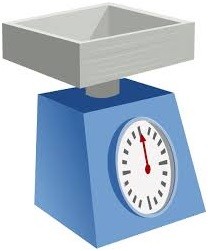Just recently our sales guys mentioned we’ve had a few calls asking about the weights of certain engineering plastics and where would they find them or be able to work them out. Typically trawling the internet confirms not just my lack of knowledge but further compassion for teachers particularly for my lack of attention at school. What i have noticed is that some of the stuff i didn’t bother learning back in the day was actually quite useful and now seems fairly interesting. Below is some of the stuff i dug up from Wikipedia sites etc (don’t shout at me if i didn’t get some of the interpretations exactly right)
If you want to though, you can skip straight to the bottom of the page to learn how to do it or even download the weights spreadsheet.
What is weight?
Weight apparently is the “gravitational force between an object (or a mass) and earth” which i take to mean that if you had two identically sized materials and one was heavier than the other, the heavier one is being attracted/pulled more by gravity than the other. In science terms, for this to happen, the heavier one somehow must have a greater “mass”
So, what is Mass?
Mass is the “amount of a substance/matter or stuff if you like an object contains” so the more stuff an object contains, the greater its mass. Therefore the greater the mass, the heavier the object (or stronger gravitational pull)
What is specific gravity?
Also known as “relative density” by the way, is the ratio of density of a material, or in other words “the mass of an object in relation to a given reference material” the reference material for solid objects if you’re interested is usually water but that’s not too critical to know at this stage, although i will mention later something that may be useful here.
So finally we’re get there, by knowing the “specific gravity/relative density” whatever you want to call it of the material that an item is made from, you can work out the weight of that item, without weighing it. Or put another way, if you knew the sizes of your component, by knowing the specific gravity of the material you want to make it out of, you could predict its weight Ta -Dah!
Specific Gravity Table
Here’s your specific gravity table which you’ll need later
|
Material |
SP/GR |
Material |
SP/GR |
|
U-PVC |
1.45 |
PVDF |
1.78 |
|
Polypropylene |
0.91 |
PEEK |
1.32 |
|
HDPE |
0.96 |
PTFE |
2.18 |
|
UHMWPE |
0.93 |
Polycarbonate |
1.20 |
|
Nylon |
1.15 |
Acylic |
1.19 |
|
Acetal |
1.41 |
Whale Tufnol |
1.36 |
|
PET |
1.39 |
Kite Tufnol |
1.36 |
|
ABS |
1.04 |
1P/13 Tufnol |
1.36 |
By the way, the potentially useful thing i mentioned earlier, is that anything in the above table with an SP/GR that is less than 1, (HDPE, UHMWPE etc) will float in water, anything with an SP/GR greater than 1 will sink
Working out your sheet/plate weights.
The formula for working the weight out of a sheet or plate item made from an engineering plastic is: Width(m) x Length(m) x Thickness(mm) x SP/GR
So for example: a 1mtr x 500mm x 10mm Acetal sheet would be (1 x 0.5 x 10 x 1.41 = 7.5kg)
The same size in nylon would be (1 x 0.5 x 10 x 1.15 = 5.75kg)
Working out rod/bar weights.
This is a little bit trickier as you need to work out the volume first, which you’ll need to use some basic volume calculations
The formula for working the weight out of a rod is: Pi x R2 x length x SP/GR
So for example (knowing Pi is approx 3.142); A 100 diameter x 1mtr length of Acetal would be:
(0.05 x 0.05 x 3.142 x 1000 x 1.41 = 11.08kg)
For 200dia x 500mm length of nylon (0.1 x 0.1 x 3.142 x 500 x 1.15 = 18.07kg)
We’ve done it for you
If you want to skip the above, we’ve created a couple of PDF spreadsheets with the materials, sizes and weights all done for you, just makes it that bit easier. You can Download Here if you like










